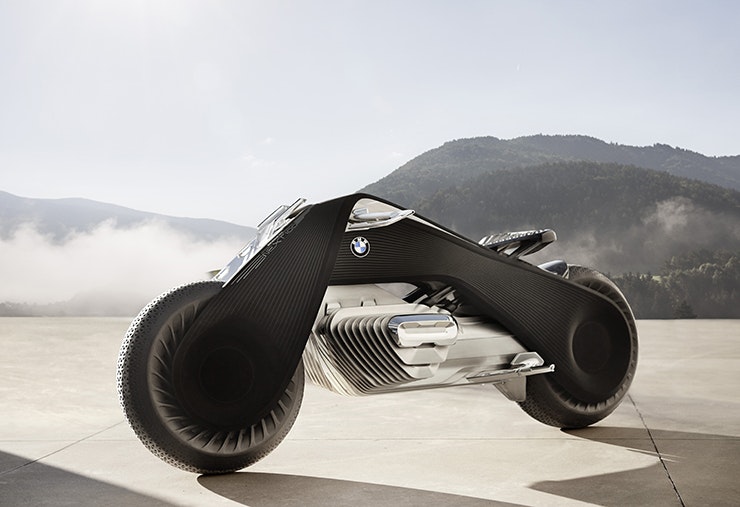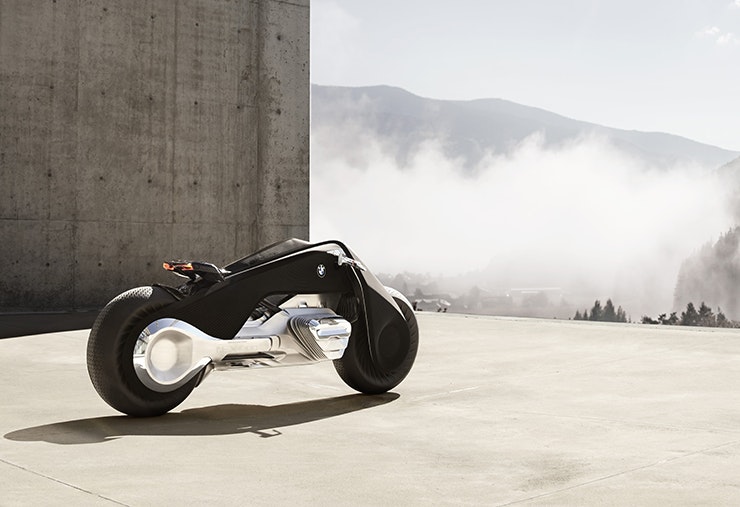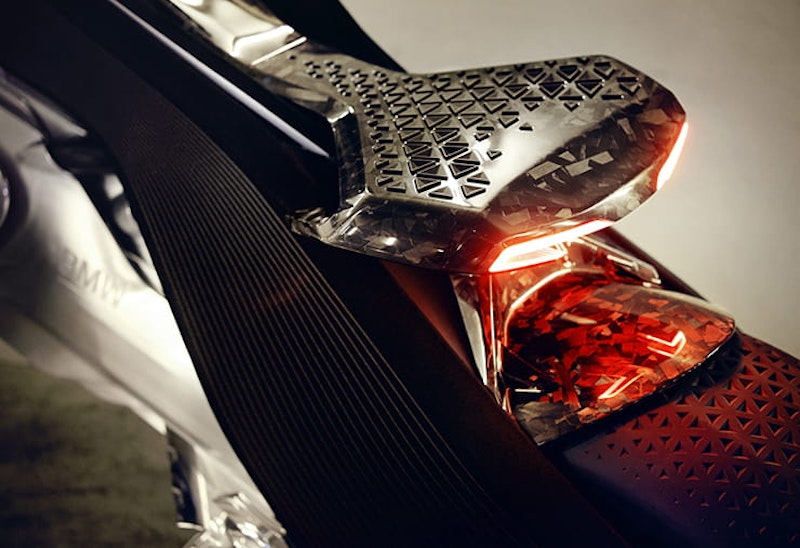The BMW we’ll be riding in 30 years
By Michael Mann
BikeSocial Managing Editor. Content man - reviewer, road tester, video presenter, interviewer, commissioner, organiser. First ride was a 1979 Honda ST70 in the back garden aged 6. Not too shabby on track, loves a sportsbike, worries about helmet hair, occasionally plays golf and squash but enjoys being a father to a 7-year old the most.
11.10.2016
Ever thought about what you’ll be riding in a few decades’ time? Or even what you’ll be wearing while doing so? BMW has offered some fascinating insight…and it won’t even fall over.
This is ‘Vision Next 100’, the project name of the bike BMW hopes we’ll be riding in 30 years’ time as the company celebrates its centenary by hosting the “Iconic Impulses. The BMW Group Future Experience” exhibition in Los Angeles.
Tron meets The Matrix? It certainly seems like the inspiration was taken from the big screen but by taking a look into the future of motorcycling, BMW have demonstrated already how they are concentrating on a zero-emissions solution. And, perhaps even more radical, a motorcycling future with no requirement for helmets or safety clothing. It also self balances.
“It’s an analogue experience in a digital age” says Edgar Heinrich, Head of Design at BMW Motorrad. "When we develop a motorcycle, we are usually thinking around five to ten years in the future. So taking a look further into the future was especially exciting for us and highly appealing".
Flying in the face of autonomous vehicles that are already being developed and tested, at least BMW are promising to retain the rider input element of actually riding a motorcycle.
The roadster-style machine still incorporates classic styling influences with the black frame triangle a deliberate reference to the R32, BMW’s first ever motorcycle made in 1923. In spite of the machine being powered by an ‘emissionless drive unit’, the polished aluminium block retains a typical boxer twin appearance and sits in a traditional space within the chassis to “optimise the aerodynamics and weather protection”, says BMW. The power unit only extends in shape to its traditional size when the bike is in motion.
The seat unit, upper frame, front wheel cover and wings are all made from carbon to save weight. The bike also doesn’t feature a centre stand, in fact it will be unnecessary.
“It will be so safe that you cannot fall over,” says Adrian van Hooydonk, Senior Vice President, BMW Group Design.
How? Intelligent assistance systems intervene to avoid critical situations and a self-balancing mechanism enhances safety by regulating banking angles for inexperienced riders and increasing dynamics for more experienced ones.
A visor but no helmet
No need for an instrument panel but that’s the least concerning when you see a motorcyclist with no helmet, right? If the BMW is not crashable then there’s no requirement for a lid. Instead, data is shown to the rider via the pair of ‘data glasses’ that shows relevant data in one of four designated display areas and are controlled by the rider’s eye movements.
Looking up or down changes the content that appears, and looking straight ahead switches the information off completely. Information is only projected onto the visor on request, or to alert the rider to the fact that action is needed. Suggested lines and hazard warning are overruled by the machine if it thinks the rider is not going to react quickly enough. It also offers support for novice riders to enhance riding skills.
Maybe BMW have yet to test the Vision Next 100 in British winter climates but I for one will be wearing at least a buff with those specs.
No leathers either?
The motorcycle suit is digitally connected and integrates with the bike and riding climate, warming or cooling the rider depending on the conditions. At higher speeds, the neck section inflates to provide extra support and BMW claims safety features are “superfluous” thanks to the bike’s intelligent assistance systems. In-built sensors monitor the wearer’s pulse rate and body temperature and adjusts itself accordingly. The suit even delivers navigation instructions via the vibrating elements in the arms and legs, and alerts the rider when the banking angle is becoming critical!
Is this the future of motorcycling? Quite possibly. Who are we to argue with a powerhouse manufacturer that looks to be enjoying its sixth successive year of sales growth with an aim of 200,000 sales for the year 2020. For us, the mere mortals who have to write about, ride and enjoy the fruits of their labour, it’s an interesting look into how a manufacturer visualises how the next generation will transport itself from A to B in 30 years’ time – advancements in robotics, technology, safety and engineering is fascinating enough and the more mechanical age will, one day, be a thing of the past. Does it excite you or scare you?
We’ll aim to bring you the first riding impressions…in the year 2045.
Share on social media:



